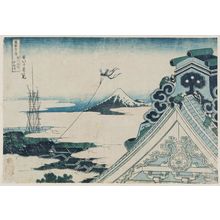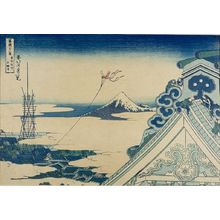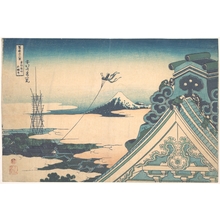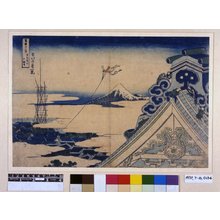Estampe japonaise "Honganji Temple at Asakusa in Edo" par Katsushika Hokusai
Artiste :Katsushika Hokusai
Titre :Honganji Temple at Asakusa in Edo
Date :c. 1830-1834
Détails :Plus d'informations...
Source :Honolulu Museum of Art
Parcourir toutes les 5 476 estampes...
Description :
Asakusa was the most populous district in Edo in Hokusai’s time. Its streets were crowded with stores where busy merchants and craftsmen lived and vigorously plied their trades. One of the district’s landmarks was the enormous Asakusa Honganji Temple, built in 1657, which belonged to a branch of Kyoto Higashi Honganji, the headquarters of Buddhism’s Eastern School of the Pure Land (Jödo) sect. Begun in the Late Heian period (late eleventh century), the Pure Land sect quickly gained a large following. It had one simple, compassionate teaching – that enlightenment (salvation) could be attained not through the study of sutras or observation of complicated rituals, as required in other sects, but simply by sincerely calling Amida’s name. In the Edo period, this teaching spread, and Pure Land became the largest Buddhist sect, with large temples all over Japan. In this composition, Hokusai brought the temple building so close to the foreground that only the triangle of the roof’s pediment is visible. Looking down, one can observe the sea of roofs of smaller houses, over which decorative clouds float. Mount Fuji, above them, repeats the roof’s shape. Hokusai’s dramatic compositional scheme enlarges the temple roof to an enormous proportion, dwarfing houses and the mountain. On the temple’s steep roof, workmen are busy making repairs. Their exaggerated, precise postures are drawn from studies Hokusai made of form and movement, which culminated in the publication of his sketchbooks, the Manga. The towering structure at the left is a scaffold rising over a well excavation. A kite indicates that the season is winter, most likely New Year’s day. The windy days of winter are best for flying kites, the symbol of the new year. Pale pink in the cloud and the kite enlivens a monochromatic blue print. The key-block was printed in blue. (The Asian Art Museum of San Francisco, HOKUSAI AND HIROSHIGE – Great Japanese Prints from the James A. Michener Collection, Honolulu Academy of Arts: The Asian Art Museum of San Francisco, 1998 Page 65. Cat. 16) ************** Mount Fuji is seen from an improbably high perspective beyond the roof of Honganji Temple, an important Pure Land Buddhist temple built in 1657 that served Edo’s most populous district of Asakusa. The roof of the temple has been cropped so that its pediment appears massive in the lower right corner, dwarfing the workmen perched precariously near the top. The roof echoes the triangular shape of Mount Fuji in the distance, while its heavy form is balanced by the delicate scaffolding on the left. Hokusai favored the technique of juxtaposing Mount Fuji with a similarly shaped architectural element seen from a cropped high perspective, and used it several times in the Thirty-six Views, with an especially close composition found in View of the Mitsui Stores at Surugachö in Edo. In addition, both prints place kites at their center, suggesting the festivities of New Year’s Day and the related symbolism of Mount Fuji for this holiday. “Hokusai’s Summit: Thirty-six Views of Mount Fuji” (09/24/2009-01/06/2010) ******************************
Estampes Similaires

























